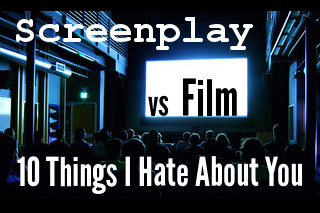Today’s Screenplay vs Film post is the teen comedy 10 Things I Hate About You, written by Karen McCullah Lutz and Kirsten Smith, the duo behind Legally Blonde & Ella Enchanted.
One of the best ways to hone your screenwriting skills is to compare a screenplay to its resulting movie. But who has the time for that? Apparently, I do, because I’m going to post the screenwriting tips I learned by doing exactly that. And on Thursdays, I’m going to post a list of plot points from the movie I analyzed. If you analyze these plot points, you should strengthen your understanding of screenwriting structure and pacing.
Last week I compared the screenplay and film versions of Salt. If you’re interested in learning from this thriller, here are the links:
Screenplay vs Film: 11 Screenwriting Tips from Salt
Screenplay vs Film: 11 Screenwriting Tips from Salt (Part 2).
And now for today’s pick: 10 Things I Hate About You. It’s about as far as you can get from a thriller like Salt, and that’s one reason I picked this teen comedy. Plus, I had a hankering to watch it again. That’s basically my reasoning. In case you’re not familiar with it, it’s a remake of Shakespeare’s classic, The Taming of the Shrew, only set in a modern-day high school. It provided breakout roles for both its leads: Julia Stiles & Heath Ledger (God bless).
The funny thing about 10 Things is that there’s not much difference between the screenplay and the movie. Unlike Salt, it didn’t have to deal with a gender switch of its main characters. Also, it benefited from being a remake of one of the Bard’s plays as Shakespeare had story structure down pat. Nevertheless, I still learned a lot of screenwriting tips from comparing the screenplay to the movie, and will again have to divide this post into two parts.
And now, without more ado, here are the screenwriting tips I learned from comparing the script and film versions of 10 Things I Hate About You:
Screenwriting Tip #1: Your hero’s introduction: decrease the bitchiness
In the screenplay version of 10 Things, when we first meet the main character, Kat Stratford, a ruffian clips her with his skateboard. In response, she shoves him into a car and presses the board into his throat. That’s a lot of bitchiness for our first introduction to her!
Of course, Kat is supposed to be a shrew. But almost choking a guy with a skateboard is just too violent — and makes her seem like a real harpy as opposed to a girl with just a harpy exterior. If Kat were the villain, it’d be one thing, but she’s supposed to be the heroine and the audience won’t want to follow her journey if they perceive her as a real bitch.
In the movie version, preppy girls sing along to the Bare Naked Ladies as they stop in front of a red light. When Kat pulls up next to them, the volume of her punk music drowns out theirs. She follows that by tearing down prom posters when she arrives at school.
It’s the perfect amount of bitchiness and mimics the way high school girls bully each other. Plus, the prom plays a key role in the plot, so it was a smart move to introduce it right away.
It does bear mentioning that if Kat had been a guy, she probably could’ve gotten away with the skateboard introduction. When guys act aggressive, they’re perceived as being “bad-ass,” and the audience will still want to follow their story. Not fair, but it’s the reality.
If you want more screenwriting tips about introducing your main character read tip #4 in 11 Screenwriting Tips from Salt. You might also be interested in this article about introducing your screenplay hero.
Screenwriting Tip #2: Write with confidence
From the minute you start reading Lutz and Smith’s screenplay, you feel like you’re in good hands. I’m not sure exactly how they accomplish this, but I definitely got that feeling when I started reading it. I think part of it is due to the way they describe high school students:
PADUA HIGH SCHOOL – DAY
Welcome to Padua High School, your typical urban-suburban high school in Portland, Oregon. Smarties, Skids, Preppies, Granolas. Loners, Lovers, the In and the Out Crowd rub sleep out of their eyes and head for the main building.
It might not be extraordinary screenwriting, but from their first line of description you get the sense that these two know exactly what high school is like, and they delight in showing it to you.
When you’re writing your own movie, and if it takes place in a world that’s different to your sphere of experience, do some research about it and then write with confidence. If you’re writing about doctors for example, and you’re by no means a neurosurgeon, don’t let your insecurity show. Shonda Rimes doesn’t have a medical degree, but she’s done alright for herself.
Screenwriting Tip #3: Give your side characters an obsession
Minor characters often aren’t as three-dimensional as main characters, most likely because they usually exist to serve a purpose. To be a mentor or a sounding board or to provide comedic relief.
One easy way to make them seem more like real people instead of cardboard characters is to give them an obsession or defining trait. 10 Things does this in spades, and it really pays off.
If you’ve seen the movie, you probably remember Miss Perky. She was not an average guidance counselor, oh no. She wanted to spend more time writing romance novels than mentoring students, and her obsession made her all the more memorable.
Miss Perky wasn’t the only one with a a defining desire. Mandella, Kat’s best friend, was so in love with William Shakespeare, she went through several half-hearted attempts to kill herself in order to join him.
More examples:
- Joey, the villain, was obsessed with his second-rate modeling career. Tube socks! Ha!
- The white rasta clique was obsessed with smoking weed and pretending to be black…
- …while the caffeine crowd was very particular about their coffee blends.
When you’re writing your own movie and your minor characters seem flat, give them a defining obsession and watch them spring to life. For a sampling of 25 obsessions, read How to Create Original Characters in Your Supporting Cast.
Screenwriting Tip #4: If a character pulls a disappearing act, eliminate him
What do I mean by disappear? In the 10 Things screenplay, Kat and Bianca’s mother was still alive, but she wasn’t in the movie much. She had a scene in the beginning, then disappeared, and didn’t emerge again until the end of the movie.
In that span of time when she wasn’t present, there were still scenes involving the Stratford family: Kat, Bianca, and their dad. Those scenes were really great; they gave a lot of heart to the story. But their mom wasn’t in any of them.
So when the screenplay was turned into a movie, they eliminated the mom character. Having the dad be a widower actually enhanced the story, because his over-protectiveness made more sense. His awkwardness about parenting two girls by himself is also very endearing.
It also makes sense plot wise. Remember, all the events of the story are driven by the fact that the dad won’t let his younger daughter date unless his older daughter does. If the mom character was still in the story, you wonder why the girls don’t just go through their mom who’d probably be more likely to relent on the rule. And if that happened, you’d have no plot! If one of your two lead characters disappears, you can’t just eliminate him! Read tip #2 in 8 Screenwriting Tips from The Tourist to see how this thriller handled that situation.
Note: in the screenplay, it was the mom character who wrote romance novels, not Miss Perky. If you do eliminate a character and they have an interesting trait, see if you can transfer that trait to another character who, if you’re following the previous screenwriting tip, might be in need of an obsession.
Screenwriting Tip #5: Name your characters wisely
Kat’s younger sister has never dated anyone. As a “pure” character, it’s fitting that she’s named Bianca, which is the Italian word for white. I don’t know for sure, but I think Kat’s name was also carefully chosen. In the original Taming of the Shrew, the female lead is named Katherina, sometimes shortened to Kate. But in 10 Things, her name is shortened to Kat. Why make that choice? Kat is handful to handle. You could compare her to a wildcat, so shortening her name to Kat could be a reference to her feral personality.
The Stratford sisters’ last name was definitely chosen with a play on words in mind since William Shakespeare was born in Stratford-upon-Avon. Kat’s love interest is named Patrick Verona. For those of you who’ve forgotten your Shakespeare, Verona is the city where Romeo & Juliet is set. Lutz & Smith aren’t done with Shakespeare puns yet. All three attend Padua High, and Padua is the setting for the Taming of the Shrew.
Names in 10 Things are also used for comedic effect. Miss Perky, is definitely chipper, but her name also serves as a contrast to some of the obscenities she uses around the students. In the screenplay, there’s also a nice joke playing on the homonyms Mandella and Nelson Mandela. The joke was eliminated in the movie, but I’m including it below for your enjoyment:
INT. TUTORING ROOM – DAY
Several pairs of tutors and students sit at the various desks.
Mandella sits with TREVOR, a White Rasta. She attempts to get him to do geometry, but he stares at her, as if smitten.
MANDELLA
Look, it’s really easy.
TREVOR
You’re a freedom fighter. Be proud, sister.
Mandella sets down her pencil and closes the book.
MANDELLA
(rotely)
It’s Mandella with two L’s. I am not related to Nelson Mandela. I am not a political figure. I do not live in South Africa. My parents just spent a few too many acid trips thinking they were revolutionaries.
TREVOR
But you freed our people.
MANDELLA
Your “people” are white, suburban high school boys who smoke too much hemp. I have not freed you, Trevor.
(grabbing his arm dramatically)
Only you can free yourself.
When you’re choosing names for your own movie, try to find names reflective of your characters’ personality or names which might lend themselves to a bit of humor. But don’t go overboard. In this case, there can be too much of a good thing!
Watching a blank screen (with modifications) by Kenneth Lu





















Comments on this entry are closed.
Funny about names. Don’t you find it quite artificial when a joke pertains to a name? Sometimes it works like in Office Space with the Michael Bolton character but personally I find it grating. Maybe just me.
Hi Dan,
Thanks for visiting Scribe Meets World! I think Karen McCullah Lutz and Kirsten Smith used names to achieve just the right amount of humor.
But you’re right. If you use names to create too many jokes, it can be grating and artificial.